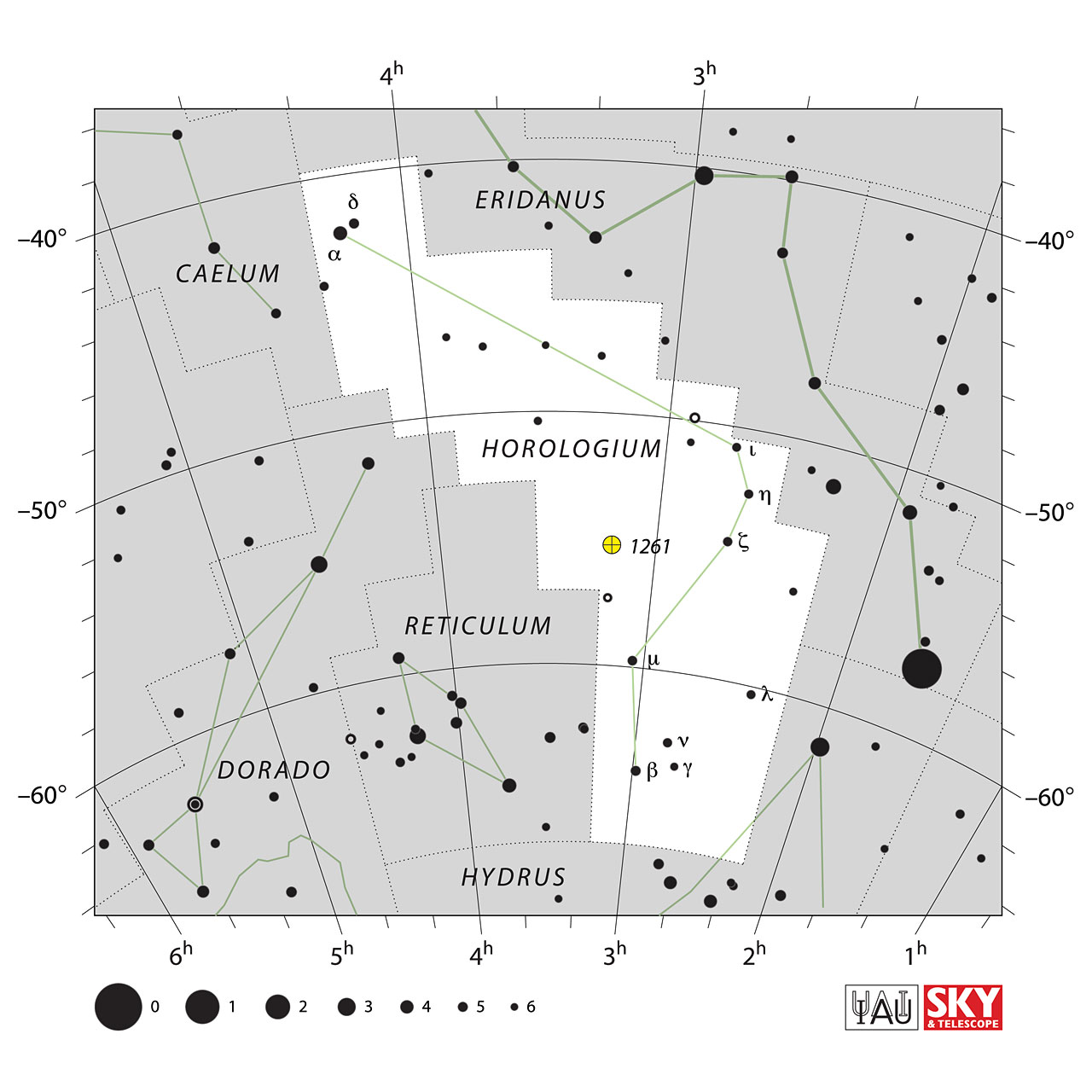Horologium


Horologium is a small southern constellation which culminates at around midnight in November.
The name ‘Horologium’ is Latin for ‘clock’, and the constellation is usually depicted as a pendulum clock. The name was assigned to this sky area by Nicolas Louis de Lacaille in 1756.
Horologium has only two stars brighter than fifth magnitude, but does have a few deep sky objects of interest, including the globular cluster NGC 1261 and the barred spiral galaxy NGC 1512.
A very much more challenging cluster is Arp-Madore 1, the most distant known globular cluster in orbit around the Milky Way. However, at magnitude 16, a large telescope is needed to see it.
In India the constellation is called ಹೋರಾಸೂಚಿ (Horasoochi)
Horologium contains:
-
Stars
- α-Hor (mag 3.9)
- δ-Hor (mag 4.9)
- β-Hor (mag 5.0)
- μ-Hor (mag 5.1)
- ζ-Hor (mag 5.2)
- ν-Hor (mag 5.3)
- η-Hor (mag 5.3)
- HD 27588 (mag 5.3)
- λ-Hor (mag 5.4)
- ι-Hor (mag 5.4)
- HD 22231 (mag 5.7)
- HD 23719 (mag 5.7)
- γ-Hor (mag 5.8)
- TW Hor (mag 5.8)
- HD 14641 (mag 5.8)
- HD 20640 (mag 5.8)
- HD 24706 (mag 5.9)
- TU Hor (mag 6.0)
- HD 18185 (mag 6.0)
- HD 19948 (mag 6.1)
- HD 17254 (mag 6.2)
- HD 18265 (mag 6.2)
- HD 16170 (mag 6.3)
- HD 17326 (mag 6.3)
- HD 15646 (mag 6.3)
-
Open Clusters
-
Globular Clusters
- NGC 1261 (mag 8.4)
-
Galaxy
- NGC 1433 (mag 10.0)
- NGC 1512 (mag 10.5)
- NGC 1448 (mag 11.5)
- NGC 1527 (mag 11.7)
- NGC 1493 (mag 11.9)
- NGC 1411 (mag 12.1)
- IC 1954 (mag 12.1)
- NGC 1249 (mag 12.2)
- NGC 1494 (mag 12.3)
- IC 1970 (mag 12.4)
- IC 2035 (mag 12.5)
- IC 2000 (mag 12.9)
- IC 1933 (mag 12.9)
- NGC 1311 (mag 12.9)
- IC 1959 (mag 13.0)
- NGC 1483 (mag 13.2)
- NGC 1510 (mag 13.2)
- IC 1914 (mag 13.3)
- NGC 1495 (mag 13.3)
- NGC 1031 (mag 13.6)
- NGC 1096 (mag 13.8)
- NGC 1136 (mag 13.8)
- NGC 1476 (mag 13.8)
- NGC 1246 (mag 13.9)
- NGC 1244 (mag 13.9)
View Horologium in 3D 
Source: Wikipedia, in-the-sky.org
Image Courtesy: Sky&Telescope & IAU, Illustration Images linked from Urania's Mirror on Wikmedia Commons by Sidney Hall
Image Courtesy: Sky&Telescope & IAU, Illustration Images linked from Urania's Mirror on Wikmedia Commons by Sidney Hall
